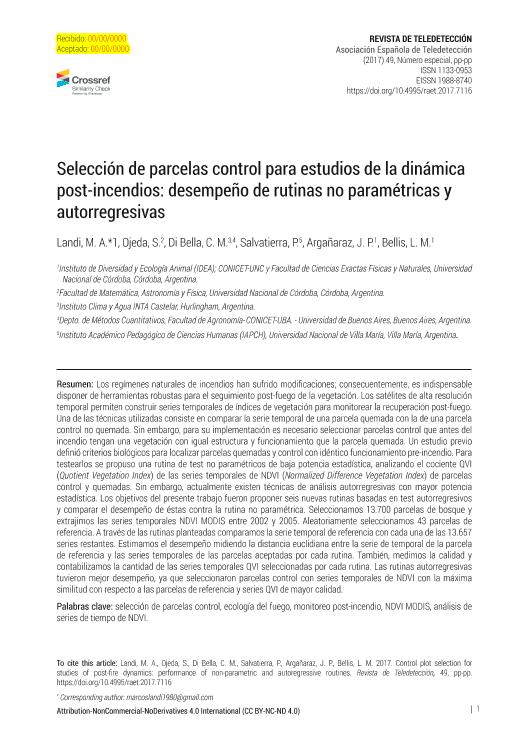Mostrar el registro sencillo del ítem
dc.contributor.author
Landi, Marcos Alejandro

dc.contributor.author
Ojeda, S.
dc.contributor.author
Di Bella, Carlos Marcelo

dc.contributor.author
Salvatierra, P.
dc.contributor.author
Argañaraz, Juan Pablo

dc.contributor.author
Bellis, Laura Marisa

dc.date.available
2018-08-24T17:28:37Z
dc.date.issued
2017-11
dc.identifier.citation
Landi, Marcos Alejandro; Ojeda, S.; Di Bella, Carlos Marcelo; Salvatierra, P.; Argañaraz, Juan Pablo; et al.; Selección de parcelas control para estudios de la dinámica post-incendios: desempeño de rutinas no paramétricas y autorregresivas; Universitat Politecnica de Valencia; Revista de Teledeteccion; 2017; 49 Special Issue; 11-2017; 79-90
dc.identifier.issn
1133-0953
dc.identifier.uri
http://hdl.handle.net/11336/57016
dc.description.abstract
Los regímenes naturales de incendios han sufrido modificaciones; consecuentemente, es indispensable disponer de herramientas robustas para el seguimiento post-fuego de la vegetación. Los satélites de alta resolución temporal permiten construir series temporales de índices de vegetación para monitorear la recuperación post-fuego. Una de las técnicas utilizadas consiste en comparar la serie temporal de una parcela quemada con la de una parcela control no quemada. Sin embargo, para su implementación es necesario seleccionar parcelas control que antes del incendio tengan una vegetación con igual estructura y funcionamiento que la parcela quemada. Un estudio previo definió criterios biológicos para localizar parcelas quemadas y control con idéntico funcionamiento pre-incendio. Para testearlos se propuso una rutina de test no paramétricos de baja potencia estadística, analizando el cociente QVI (Quotient Vegetation Index) de las series temporales de NDVI (Normalized Difference Vegetation Index) de parcelas control y quemadas. Sin embargo, actualmente existen técnicas de análisis autorregresivas con mayor potencia estadística. Los objetivos del presente trabajo fueron proponer seis nuevas rutinas basadas en test autorregresivos y comparar el desempeño de éstas contra la rutina no paramétrica. Seleccionamos 13.700 parcelas de bosque y extrajimos las series temporales NDVI MODIS entre 2002 y 2005. Aleatoriamente seleccionamos 43 parcelas de referencia. A través de las rutinas planteadas comparamos la serie temporal de referencia con cada una de las 13.657 series restantes. Estimamos el desempeño midiendo la distancia euclidiana entre la serie de temporal de la parcela de referencia y las series temporales de las parcelas aceptadas por cada rutina. También, medimos la calidad y contabilizamos la cantidad de las series temporales QVI seleccionadas por cada rutina. Las rutinas autorregresivas tuvieron mejor desempeño, ya que seleccionaron parcelas control con series temporales de NDVI con la máxima similitud con respecto a las parcelas de referencia y series QVI de mayor calidad.
dc.description.abstract
Natural fire regimes have been modified; therefore robust post-fire monitoring tools are needed to understand the post-fire recovery process. Satellites with high temporal resolution allow us to build time series of vegetation indices for monitoring post-fire vegetation recovery. One of the techniques used is to compare the time series of a burned plot with that of an unburned control plot. However, for its implementation it is necessary to select control plots in which the vegetation has the same structure and functioning than the plot burned before the fire. Previous study defined biological criteria to detect burned and unburned control plots with identical pre-fire vegetation functioning. Moreover, a non-parametric test routine of low statistical power was proposed to test them, this was based on the analysis of the QVI (Quotient Vegetation Index), calculated between NDVI (Normalized Difference Vegetation Index) time series of the burned and control site. However, currently there are autoregressive analysis techniques with greater statistical power. Therefore the aims were to propose six new statistical routines based on autoregressive test, and compare the performance of these with the non-parametric routine. We selected 13,700 forest plots and extracted the NDVI MODIS time series between 2002 and 2005. We randomly selected 43 reference plots, and through each routine, we compared each reference time series with the other 13,657 time series. We estimated the performance of the routines measuring the euclidian distance between the time series of the reference plot and the time series of the plots accepted for each routine. We also measured the quality and the amount of the QVI time series selected by each routine. Autoregressive routines showed better performance than the non-parametric routine, since they selected control plots with NDVI time series with greatest similarity with respect to the reference plots and QVI series with highest quality.
dc.format
application/pdf
dc.language.iso
spa
dc.publisher
Universitat Politecnica de Valencia
dc.rights
info:eu-repo/semantics/openAccess
dc.rights.uri
https://creativecommons.org/licenses/by-nc-sa/2.5/ar/
dc.subject
Control Plot Selection
dc.subject
Fire Ecology
dc.subject
Ndvi Modis
dc.subject
Ndvi Time Series Analysis
dc.subject
Post-Fire Monitoring
dc.subject.classification
Meteorología y Ciencias Atmosféricas

dc.subject.classification
Ciencias de la Tierra y relacionadas con el Medio Ambiente

dc.subject.classification
CIENCIAS NATURALES Y EXACTAS

dc.title
Selección de parcelas control para estudios de la dinámica post-incendios: desempeño de rutinas no paramétricas y autorregresivas
dc.title
Control plot selection for studies of post-fire dynamics: performance of non-parametric and autoregressive routines
dc.type
info:eu-repo/semantics/article
dc.type
info:ar-repo/semantics/artículo
dc.type
info:eu-repo/semantics/publishedVersion
dc.date.updated
2018-08-17T14:32:35Z
dc.identifier.eissn
1988-8740
dc.journal.volume
2017
dc.journal.number
49 Special Issue
dc.journal.pagination
79-90
dc.journal.pais
España

dc.journal.ciudad
Valencia
dc.description.fil
Fil: Landi, Marcos Alejandro. Consejo Nacional de Investigaciones Científicas y Técnicas. Centro Científico Tecnológico Conicet - Córdoba. Instituto de Diversidad y Ecología Animal. Universidad Nacional de Córdoba. Facultad de Ciencias Exactas Físicas y Naturales. Instituto de Diversidad y Ecología Animal; Argentina
dc.description.fil
Fil: Ojeda, S.. Universidad Nacional de Córdoba. Facultad de Matemática, Astronomía y Física; Argentina
dc.description.fil
Fil: Di Bella, Carlos Marcelo. Instituto Nacional de Tecnología Agropecuaria. Centro de Investigación de Recursos Naturales. Instituto de Clima y Agua; Argentina
dc.description.fil
Fil: Salvatierra, P.. Universidad Nacional de Villa María; Argentina
dc.description.fil
Fil: Argañaraz, Juan Pablo. Consejo Nacional de Investigaciones Científicas y Técnicas. Centro Científico Tecnológico Conicet - Córdoba. Instituto de Diversidad y Ecología Animal. Universidad Nacional de Córdoba. Facultad de Ciencias Exactas Físicas y Naturales. Instituto de Diversidad y Ecología Animal; Argentina
dc.description.fil
Fil: Bellis, Laura Marisa. Consejo Nacional de Investigaciones Científicas y Técnicas. Centro Científico Tecnológico Conicet - Córdoba. Instituto de Diversidad y Ecología Animal. Universidad Nacional de Córdoba. Facultad de Ciencias Exactas Físicas y Naturales. Instituto de Diversidad y Ecología Animal; Argentina
dc.journal.title
Revista de Teledeteccion
dc.relation.alternativeid
info:eu-repo/semantics/altIdentifier/url/https://polipapers.upv.es/index.php/raet/article/view/7116
dc.relation.alternativeid
info:eu-repo/semantics/altIdentifier/doi/https://doi.org/10.4995/raet.2017.7116
Archivos asociados
